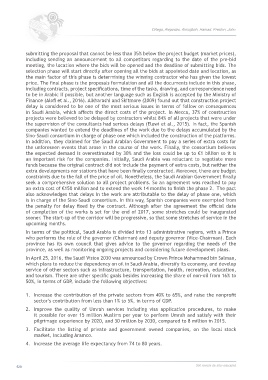Page 522 - 360.revista de Alta Velocidad - Nº 6
P. 522
Ortega, Alejandro. Almujibah, Hamad. Preston, John.
submitting the proposal that cannot be less than 35% below the project budget (market prices),
including sending an announcement to all competitors regarding to the date of the pre-bid
meeting, the location where the bids will be opened and the deadline of submitting bids. The
selection phase will start directly after opening all the bids at appointed date and location, as
the main factor of this phase is determining the winning contractor who has given the lowest
price. The final phase is the proposals formulation and all the documents include in this phase,
including contracts, project specifications, time of the tasks, drawing, and correspondence need
to be in Arabic if possible, but another language such as English is accepted by the Ministry of
Finance (Alofi et al., 2016). Alkharashi and Skitmore (2009) found out that construction project
delay is considered to be one of the most serious issues in terms of follow on consequences
in Saudi Arabia, which affects the direct costs of the project. In Mecca, 37% of construction
projects were believed to be delayed by contractors whilst 84% of all projects that were under
the supervision of the consultants had serious delays (Elawi et al., 2015). In fact, the Spanish
companies wanted to extend the deadlines of the work due to the delays accumulated by the
Sino-Saudi consortium in charge of phase one which included the construction of the platforms.
In addition, they claimed for the Saudi Arabian Government to pay a series of extra costs for
the unforeseen events that arose in the course of the work. Finally, the consortium believes
the expected demand is overestimated by 30% and the loss could be up to €1 billion so it is
an important risk for the companies. Initially, Saudi Arabia was reluctant to negotiate more
funds because the original contract did not include the payment of extra costs, but neither the
extra developments nor stations that have been finally constructed. Moreover, there are budget
constraints due to the fall of the price of oil. Nonetheless, the Saudi Arabian Government finally
seek a comprehensive solution to all project problems. So an agreement was reached to pay
an extra cost of €150 million and to extend the work 14 months to finish the phase 2. The pact
also acknowledges that delays in the work are attributable to the delay of phase one, which
is in charge of the Sino-Saudi consortium. In this way, Spanish companies were exempted from
the penalty for delay fixed by the contract. Although after the agreement the official date
of completion of the works is set for the end of 2017, some stretches could be inaugurated
sooner. The start-up of the corridor will be progressive, so that some stretches of service in the
upcoming months.
In terms of the political, Saudi Arabia is divided into 13 administrative regions, with a Prince
who performs the role of the governor (Chairman) and deputy governor (Vice-Chairman). Each
province has its own council that gives advice to the governor regarding the needs of the
province, as well as monitoring ongoing projects and considering future development plans.
In April 25, 2016, the Saudi Vision 2030 was announced by Crown Prince Mohammed bin Salman,
which plans to reduce the dependency on oil in Saudi Arabia, diversify its economy, and develop
service of other sectors such as infrastructure, transportation, health, recreation, education,
and tourism. There are other specific goals besides increasing the share of non-oil from 16% to
50%, in terms of GDP, include the following objectives:
1. Increase the contribution of the private sectors from 40% to 65%, and raise the nonprofit
sector’s contribution from less than 1% to 5%, in terms of GDP.
2. Improve the quality of Umrah services including visa application procedures, to make
it possible for over 15 million Muslims per year to perform Umrah and satisfy with their
pilgrimage experience by 2020, and 30 million by 2030, compared to 8 million in 2015.
3. Facilitate the listing of private and government owned companies, on the local stock
market, including Aramco.
4. Increase the average life expectancy from 74 to 80 years.
520 360.revista de alta velocidad

